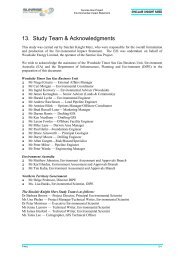Appendix D Terrestrial and Aquatic Biodiversity - Environment ...
Appendix D Terrestrial and Aquatic Biodiversity - Environment ...
Appendix D Terrestrial and Aquatic Biodiversity - Environment ...
You also want an ePaper? Increase the reach of your titles
YUMPU automatically turns print PDFs into web optimized ePapers that Google loves.
• Fine scale vegetation mapping (1:25,000 scale) – delineating <strong>and</strong> describing vegetation types;<br />
• Habitat characterisation – either confirming existing l<strong>and</strong> system mapping or characterising particular<br />
areas either relating to fauna assessments or survey for notable habitat; <strong>and</strong><br />
• Local assessment for the presence of weed species.<br />
A summary of the levels of vegetation assessment applied to each of the three key development areas is<br />
presented in Table 2.<br />
All levels of vegetation mapping <strong>and</strong> habitat characterisations have followed the Northern Territory<br />
Guidelines <strong>and</strong> Field Methodology for Vegetation Survey <strong>and</strong> Mapping (Brocklehurst et al. 2007), with some<br />
minor modifications. Vegetation mapping <strong>and</strong> habitat characterisation comply with descriptions to NVIS<br />
Level V, which encompasses a description of the broad structural formation (e.g. woodl<strong>and</strong>, canopy height<br />
<strong>and</strong> projective cover) <strong>and</strong> the dominant species in three strata (Upper overstorey, Midstorey <strong>and</strong> Ground<br />
Layer). In all cases disturbance attributes such as grazing, fire <strong>and</strong> introduced plants have been recorded as<br />
part of the vegetation assessments which enables some interpretation of vegetation condition.<br />
Weed assessment has focused on detecting weed presence along accessible road sides <strong>and</strong> some limited<br />
surveying within high value habitats along the haul road. Recording weed presence aligns with the<br />
Guidelines for Weed Data Collection in the Northern Territory – Version 3 (2010) whereby the weed density<br />
(in terms of cover) is estimated within a nominated area (a 25m x 25m quadrat in most cases).<br />
The following outlines the focus <strong>and</strong> justification for vegetation assessment for each the proposed<br />
development envelopes.<br />
Mine <strong>and</strong> Site Camp Area<br />
Given the MLA areas are potentially targeted for substantial disturbance (inclusive of alteration to ground<br />
water levels <strong>and</strong> rehabilitation with altered substrates) vegetation mapping has been refined to NVIS level V<br />
at 1:25,000 scale. The main purpose <strong>and</strong> objectives for mapping <strong>and</strong> surveying the vegetation within this<br />
development area have included:<br />
• Providing a fine scale map <strong>and</strong> description of the existing vegetation types to NVIS level V; <strong>and</strong><br />
• Scoping the potential for notable species (i.e. rare, threatened or restricted in range).<br />
The resultant vegetation map <strong>and</strong> assessment compliments additional environmental studies for the Mine<br />
<strong>and</strong> Camp site including:<br />
• Interpreting surface flows, presence of wetl<strong>and</strong>s <strong>and</strong> seasonally inundated areas;<br />
• Identifying the range aquatic ecosystems present within the potential impact zone <strong>and</strong> hence<br />
targeting surveys to examine the values of these systems;<br />
• Providing a base map for interpreting the presence of likely ground water dependent ecosystems;<br />
<strong>and</strong><br />
• Providing a basis for defining potential rehabilitation objectives <strong>and</strong> targets.<br />
Haul Road<br />
L<strong>and</strong> Systems <strong>and</strong> Vegetation Types<br />
The proposed haul road traverses 165km <strong>and</strong> crosses several l<strong>and</strong> system <strong>and</strong> vegetation types. The<br />
majority of l<strong>and</strong> systems which the transport route plans to intersect are extensive <strong>and</strong> common within the<br />
Gulf area <strong>and</strong> the Northern Territory. The main purpose of vegetation assessment for this potential<br />
development zone has been to confirm <strong>and</strong> supplement existing l<strong>and</strong> system mapping at (1:250,000 scale by<br />
Aldrick et al. 1990) <strong>and</strong> primarily focus on delineating <strong>and</strong> characterising notable habitats (or those preferably<br />
avoided) within a 6km wide corridor of the potential transport route (3km either side of the centre line). The<br />
notable habitats targeted included: rocky ridges, tributaries, water bodies <strong>and</strong> vegetation types inclusive of<br />
rainforest, monsoonal vine thicket <strong>and</strong> riparian vegetation.<br />
Client: Western Desert Resources Ltd Page 14 of 150<br />
Doc No. DW120004-C0302-EIA-R-0036<br />
Doc Title: <strong>Appendix</strong> D – <strong>Terrestrial</strong> <strong>Biodiversity</strong> Technical Report



